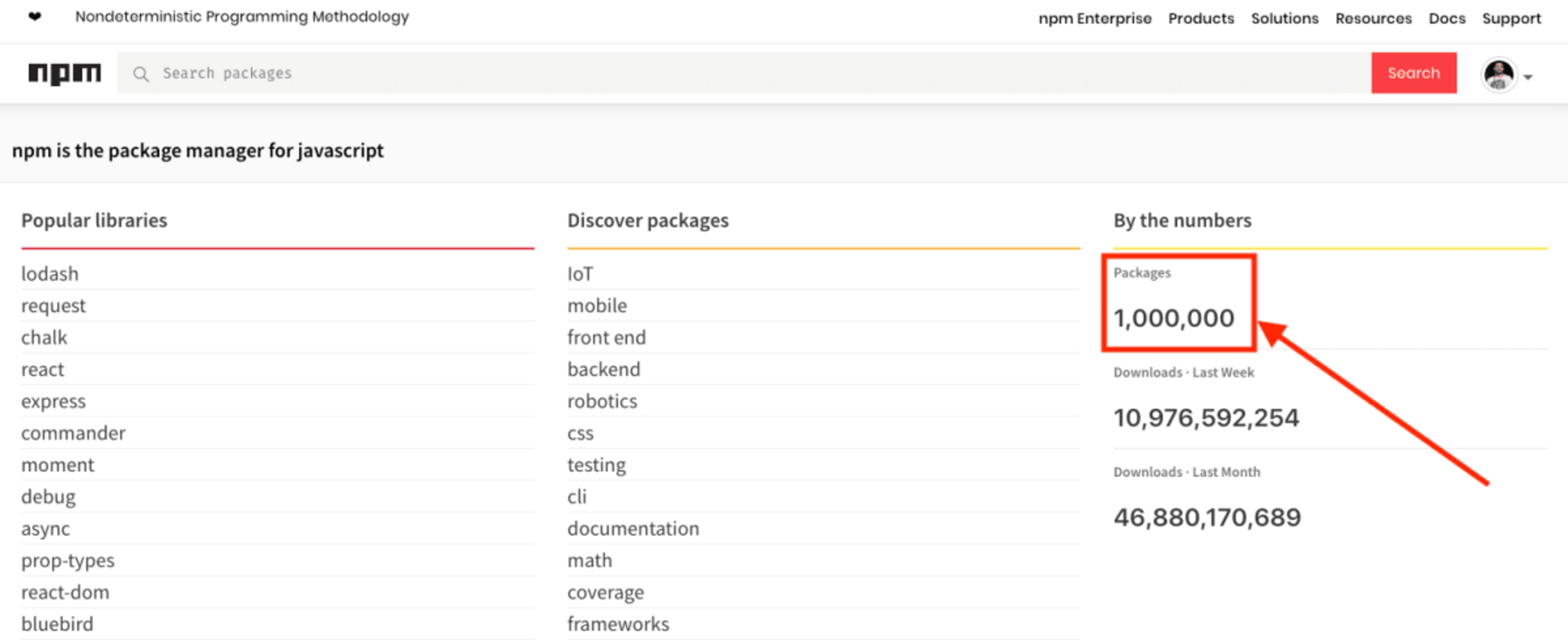npm passes the 1 millionth package milestone! What can we learn?
4 de junho de 2019
0 minutos de leitura
June 4th is a historic date. Not only is it our very own Liran Tal’s birthday (Mazal Tov, Liran!) but it is also the date that the millionth package was indexed into the npm registry. npm is a package manager for JavaScript packages. The core component of npm is its public registry, hosting JavaScript packages that can be accessed by the npm client to build JavaScript applications.

If you’re a user of npm and are interested in how you can use it more securely, be sure to read our npm security cheatsheet, listing ten top best practices on how to use npm safely.
A brief history of npm, including security incidents
January 2010: npm was created by Isaac Z. Schlueter, written in JavaScript.
March 2016: popular JavaScript package, left-pad, was unpublished from the npm repository due to a naming dispute. After much disruption among the JavaScript world, tightened up its unpublishing policy.
July 2018: a malicious version of the eslint-scope package was released which exposed npm credentials of users to the attacker.
November 2018: the malicious package, flatmap-stream, was released to npm which was added as a dependency to the popular event-stream package. The package targeted Copay the bitcoin wallet.
June 4th 2019: npm indexes its one-millionth package.
npm’s top ten packages
The npm website lists its top ten most popular packages. These are as listed below, with vulnerability information included. Interestingly, the request package has seen 17 typosquatting attempts.
Package | Vulnerabilities |
|---|---|
3 vulnerabilities (1 high sev) | |
1 vulnerability (17 typosquatting attempts) | |
0 vulnerabilities (1 typosquatting attempt) | |
2 vulnerabilities (1 high sev) | |
1 vulnerability | |
0 vulnerabilities | |
3 vulnerabilities | |
1 vulnerability | |
0 vulnerabilities | |
0 vulnerabilities |
If we consider popularity as the number of total downloads we can see which libraries are used heavily both as direct and indirect dependencies:
Package | Downloads |
|---|---|
debug | >40 million weekly downloads |
kind-of | >34 million weekly downloads |
supports-color | >34 million weekly downloads |
readable-stream | >31 million weekly downloads |
source-map | >30 million weekly downloads |
yargs | >27 million weekly downloads |
camelcase | >26 million weekly downloads |
minimist | >25 million weekly downloads |
strip-ansi | >25 million weekly downloads |
chalk | >25 million weekly downloads |
Out of the above 10 packages, only debug was found to contain a security vulnerability.
npm by numbers
The sheer scale of the popularity and growth of npm is staggering as we can see from this graph, showing the number of indexed packages over just the last couple of years. In fact, we see a 250% growth of the platform in just over 2 years, since January 2017.

Even month-by-month the growth of npm usage is visible, as we can see from the number of packages that are downloaded each month in 2019.

Here are some more npm stats:
1 million indexed packages (+ those that have been indexed since this post was written!)
10.9 billion downloads last week
46.9 billion downloads last month
The top package is
debugand accounts for more than 40 million weekly downloadsThe 1000th most downloaded package is merge-stream and accounts for about 3.5 million downloads a week
250kpackages added to npm in 2018
110kpackages added to npm in 2019, so far
144k downloads of the Snyk CLI npm package each week!
41 packages are owned by Snyk, yay!
GitHub user, dominykas, and a friend from NearForm, provided some stats in a GitHub issue as part of some work being done in the Node.js Foundation’s Package Maintenance working group. Their data shows how general package maintenance varies significantly between authors.
Percentile | Last commit | Last publish |
|---|---|---|
10% | 4 days old | 11 days old |
20% | 5 days old | 37 days old |
30% | 19 days old | 88 days old |
40% | 57 days old | 157 days old |
50% | 119 days old | 246 days old |
60% | 194 days old | 369 days old |
70% | 328 days old | 559 days old |
80% | 563 days old | 777 days old |
90% | 887 days old | 1098 days old |
95% | 1194 days old | 1372 days old |
100% | 2201 days old | 2792 days old |
Summary
We’d like to send our congratulations to npm for running and maintaining the largest open source language repository, and to the great maintainers and developers in the community who power the ecosystem and assisted in reaching this great achievement. It’s extremely important to make sure that when you use open source packages, you use versions that do not contain known vulnerabilities. It’s straightforward to test your applications for free against the industry-leading Snyk vulnerability database. Try it now, and see the scan results instantly.
Test your JavaScript app with a free Snyk account today.
Primeiros passos com Capture the Flag
Saiba como resolver desafios de Capture the Flag assistindo ao nosso workshop virtual de conceitos básicos sob demanda.
